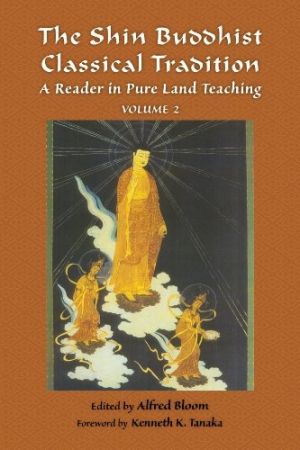The Shin Buddhist Classical Tradition
A Reader in Pure Land Teaching, Volume 2
Buddhist scholars and general readers will find much to enjoy in this welcome second volume.
The Shin Buddhist Classical Tradition: A Reader in Pure Land Teaching; Volume Two, edited by Alfred Bloom, is an exceptional book that expertly and accessibly brings together fourth- to fifteenth-century East Asian Pure Land writings, including sermons, poetry, letters, commentaries, and more. With its focus on the religious practice of the Pure Land Teachings, this volume offers existing Pure Land Buddhists as well as curious newcomers a compelling immersion into the spiritually rich world of the Pure Land philosophy.
The Pure Land teachings are founded on the myriad interpretations of Amida Buddha’s controversial eighteenth vow, which asserts that anyone who faithfully recites Amida Buddha’s name a minimum of ten times before death will be guaranteed rebirth in the Pure Land, a heaven-like place where one is freed from the wheels of rebirth, regardless of past karma or bad behavior in one’s present life. Most often interpreted as a compassionate gesture to the masses of humanity who, due to ignorance or lack of exposure to the Buddha’s teachings, were otherwise destined for the many levels of hell or an all-but-unattainable enlightenment, the eighteenth vow’s promise was a game changer in early Buddhism.
The well-organized content of The Shin Buddhist Classical Tradition: A Reader in Pure Land Teaching; Volume Two shares multiple analyses of the eighteenth vow by preeminent monks and teachers whose writings span eleven centuries. Their spiritually and historically relevant debates about who gets into the Pure Land and how it is to be done often feel like explorations of contemporary existential issues in the local coffee shop.
The first section, “Pure Land Practice,” has twelve subsections with titles such as “Aspiration for Birth in the Pure Land, Repentance, Gratitude,” and “Self-Power and Other-Power.” These writings delve into the minutiae of how much or how little faith one actually needs for salvation, and whether the devout and long-practicing monk is any more likely to attain rebirth in the Pure Land than the most lowly and evil person who, for the first time, recites Amida Buddha’s name on his deathbed.
These themes carry over into the second section, “The Human Condition,” the first subsection of which is aptly titled “Foolish Being.” One of the more inspiring scholars, Genshin, proposes, “If we recite the nembutsu [Amida Buddha’s name] while resigned to the fact that we are to remain ordinary beings full of delusion until death, we shall be received in welcome by Amida; then, as soon as we mount the lotus seat, our mind of delusion will be turned into that of Enlightenment.”
Bloom has done an exemplary job of editing this professionally packaged two-hundred-plus-page book. The foreword and introduction provide a valuable overview of Shin Buddhism and the Pure Land teachings that will help even the most unfamiliar reader. The variety of millennia-spanning writing styles, from serious and dogmatic to gentle and conversational, adds value and readability to this collection, as does the inclusion of many beautiful poems and a highly usable glossary. Buddhist scholars and general readers alike will find much to enjoy in this welcome second volume of The Shin Buddhist Classical Tradition: A Reader in Pure Land Teaching.
Reviewed by
Patty Sutherland
Disclosure: This article is not an endorsement, but a review. The publisher of this book provided free copies of the book and paid a small fee to have their book reviewed by a professional reviewer. Foreword Reviews and Clarion Reviews make no guarantee that the publisher will receive a positive review. Foreword Magazine, Inc. is disclosing this in accordance with the Federal Trade Commission’s 16 CFR, Part 255.

